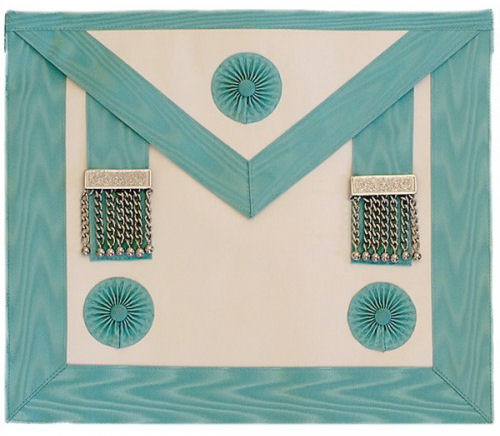
The Three Rosettes on a Master Mason's Apron
R.W. Bro. Otto Klotz

The Rose, the Queen of Flowers, is the symbol of beauty, of youth, of love, of joy, and of silence. In the ancient mysteries, in mythology among the ancient Hebrews and other nations the rose was ever considered a very important symbol.
The ancient Greeks dedicated the Rose, as the symbol of beauty, to Aphrodite the goddess of love. The Flora of Spring carries a rose in her hand, and Homer assigns rosy fingers to Aurora. Among the Hebrews it was customary to decorate themselves with roses at joyous festivals, hence the passage in Wisdom of Solomon: "Let us crown ourselves with rose-buds before they withered." The same custom obtained among the Greeks and the Romans. Among the latter the Romans, this caution was particularly popular, during the winter whole cargoes of roses were shipped from Alexandria to Rome. At banquets the guests were seated upon cushions filled with rose leaves. Among the Sybarites it was the custom to sleep upon rose leaves. In Egypt and Greece the candidates for initiation into the mysteries especially wore roses; and roses were the constant ornaments of the temples during the ceremony of dedication and opening the feasts of the mysteries. The object of decorating the candidates for initiation with roses being to intimate to them, that that which had been communicated to them as secrets (sub-rosa) they were bound to preserve with inviolable silence, hence the rose, especially among the Freemasons, is considered as the symbol of silence which the candidate not only promised to observe but a silence which he faithfully and inviolably observed.
A similar custom as that practiced in the ancient Egyptian and Greek mysteries, obtained among the ancient Germans at their banquets, a wreath of flowers with a rose in its centre was suspended from the ceiling over the banquet table, as a symbol that everything that was spoken during those social gatherings should be kept as a secret among the partakers of those banquets.
This custom we find even at more recent periods, in several other countries the guests that were entertained at particular banquets wore a rose as a part of their head dress, while on the ceiling and upon the tables roses were either painted or produced in a natural state, for a like purpose, i.e. as the symbol of silence.
It is thus that the rose, the queen of flowers, became the favorite flower of the Freemasons, the disciples of the Royal Art, and the greatest of their festivals that of St. John the Baptist, is richly decorated with roses, thus reminding every Freemason of the three-fold meaning of that emblem of Love, of Joy, and of Silence.
The three Rosettes on a Master Mason's Apron indicate that every Master Mason has thrice been obliged to Fidelity, to Secrecy, and to Silence: Fidelity to the Craft, Secrecy as regards our sacred Secrets, and Silence as to the proceedings of the Lodge, which should never be disclosed to the profane.
Published in The Craftsman, on 1875-01-01
![]()